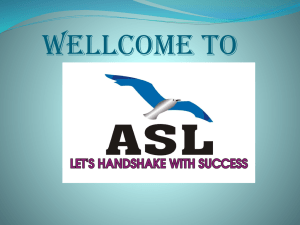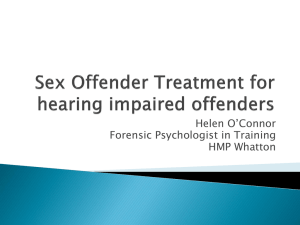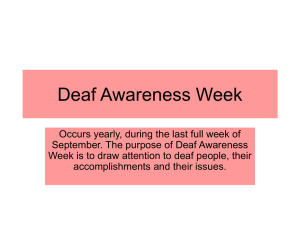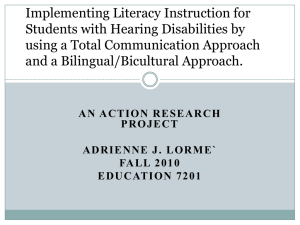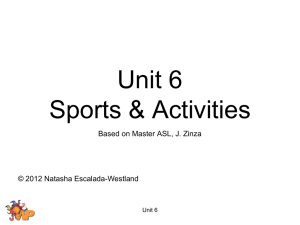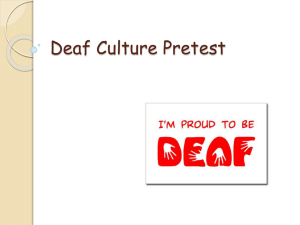MASL Unit 1 ppt.
advertisement
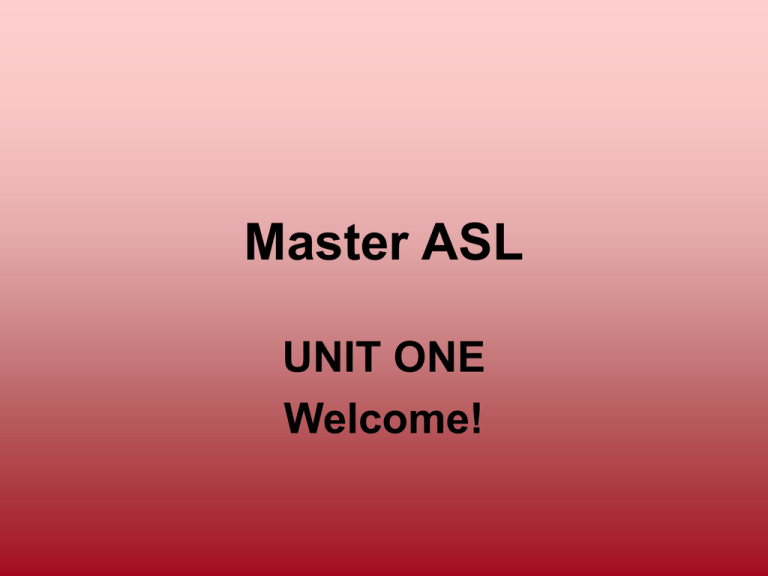
Master ASL UNIT ONE Welcome! Unit One Objectives • To learn proper greetings and farewells in ASL • To introduce yourself and others • To learn basic ASL sentence Structure • To ask and answer questions • To learn how to interact appropriately with Deaf people • To learn the role of facial expressions and non manual signals Survival Signs Teachers from Kent, Wa. http://www.youtube.com/watch?v=TBK9A2b 2bZE Unit 1 Vocabulary Teachers from Kent, Wa. • http://www.youtube.com/watch?v=V6mAL GJebmA • part A • http://www.youtube.com/watch?v=y0zLEKbB0H E • part B • http://www.youtube.com/watch?v=zrIIElhh 1FA • part C Lesson One pp 4-8 Outcomes: Can exchange and respond to formal and informal greetings Demonstrate a variety of responses about one’s state of being Uses deixis with eye gaze • Greetings • Formal vs informal • Eyes on ASL #1 *Eye contact • Deixis w eye gaze Homework Ex 1 pg 8 Objective: Can explain how to introduce oneself in the culturally appropriate manner Lesson Two pp 9-10 Outcomes: Asks for and provides first and last name in a culturally appropriate manner. Can fingerspell first and last name clearly Uses the closing signal at the end of sentences Responds to questions in a complete sentence Can fingerspell the ASL alphabet • • • • • Closing signals Names Fingerspelling Eyes on ASL 2 *Closing Signals Eyes on ASL3 *One word answers. Lesson Three pp 11-13 Outcomes: Can introduce oneself and mention hearing status Can introduce two individuals by name and mention hearing status • Introducing oneself • Hearing status • Making introductions CULTURE Lesson Four p 14 Outcomes: Understands behavioral expectations within the Deaf community regarding attentiongetting strategies and use of voice. • Interacting with Deaf people Lesson Five pp 15-18 Outcomes: Uses the Question-Marker non-manual signal to ask simple yes/no questions Understands differences between questions and statements Demonstrates receptive and expressive understanding of ASL numbers 1-10, Including palm orientation for numbers 1-5 • The Question Maker • Numbers 1- 10 Lesson Six pp 19-21 Outcomes: Can express farewells in a variety of forms Adopts the cultural model of mentioning the next time individuals will see each other again • • Farewells Making plans to meet again CULTURE Lesson Seven pp 22-24 Outcomes: Understands ASL was forbidden at school for the Deaf and gradually gained acceptance in the 1960’s and 1970’s gains exposure to several learning strategies Understands ASL and English are distinct and separate languages Practice analyzing the root concepts of English words to determine similar or different ASL concepts Lesson Eight pp 25-32 Outcomes: Can apply a variety of facial expressions to signs to modify meaning; integrates appropriate non-manual signals when responding to yes/no questions; pairs the headshake and head nod non-manual signal with specific vocabulary items. • Non-manual signals • Eyes on ASL 4 • Headshake & head nod Master ASL UNIT ONE Lesson One Lesson One pp4-8 Outcomes: Can exchange and respond to formal and informal greetings Demonstrate a variety of responses about one’s state of being Uses deixis with eye gaze • Greetings • Formal vs informal • Eyes on ASL #1 *Eye contact • Deixis w eye gaze Homework Ex 1 pg 8 Objective: Can explain how to introduce oneself in the culturally appropriate manner Meet the Characters MASL p 3 Greetings Words you need to know • HELLO • HI • WHAT’S-UP? • HOW-ARE-YOU? • FINE MASL p 4 Formal or Informal FORMAL INFORMAL Signing to adults, people you don’t know well. Signing to friends and peers Use: HELLO HOW-ARE-YOU? Use: HI WHAT’S-UP? Classroom Exercise 3. Greetings Look at the list of people. Would you use What’s-up or How-are-you to greet them? • • • • • • • • • • an acquaintance parents an ASL student your partner an ASL teacher grandmother buddy younger brother teacher school administrator MASL p 5 Formal or Informal • When signing to friends sign Hi! • When signing with adults or people you don’t know well, use the more formal Hello. • What’s-up? is an informal way to ask How-areyou? • How-are-you? Is formal in both English and in ASL. Note: you can sign What’s-up? one-handed, but both signs must include raising your chin. MASL p 4 Vocabulary How are you? & What’s up? • • • • • • • • • • BUSY CONFUSED FINE GOOD/WELL HAPPY NOTHING/NOTMUCH SAME OLD/THE USUAL SLEEPY SO-SO TIRED MASL p 5 Classroom Exercise 1. Hello! Exchange greetings with a classmate and ask how he or she is doing. Vocabulary: HELLO, HI, WHAT’S UP? HOW-ARE-YOU? BUSY, CONFUSED, FINE, GOOD/WELL, HAPPY, NOTHING/NOT MUCH, SAME OLD/THE USUAL, SLEEPY, SO-SO, TIRED 2. How are you? Ask a partner to tell you how another classmate is doing? HINT: you may have to stop and ask the other classmate how they are to be able to answer the your partner’s question. MASL p 5 ASL Up Close Deixis Pointing is a logical feature of a signed, non spoken language. It is not considered rude or impolite. If a person or object is not visible, point to an empty space and continue signing. Using the index finger to point is called deixis. Conjugating Verbs: To Be I, I am, me, You, you are, He, she, it is, We, we are, us You, you are (plural) They, they are, MASL p 6 Classroom Exercise How is everybody. Sign each sentence in ASL following the example. Use deixis as needed. example: • • • • • • • • I SO-SO I (I’m not too bad.) They are busy. She is happy. I am confused We are happy. She’s good. I’m sleepy. It’s so-so He’s fine FYI Don’t forget to point back to the person MASL p 6 Vocabulary More Greetings • Good+afternoon • Good+evening/night • Good+morning “American Sign Language is of great value to the deaf, but could also be of great benefit to the hearing as well… It is superior to spoken language in its beauty and emotional expressiveness. It brings kindred souls into a much more close and conscious communion than mere speech can possibly do.” –Thomas H. Gallaudet 1848 Classroom Exercise 1. 2. Greetings Greet your class mate and ask how they are doing. Dialogue Work with a partner to sign a dialogue using vocabulary you have already learned. Vocabulary: HELLO, HI, WHAT’S UP? HOW-ARE-YOU? BUSY, CONFUSED, FINE, GOOD/WELL, HAPPY, NOTHING/NOT MUCH, SAME OLD/THE USUAL, SLEEPY SO-SO, TIRED GOOD MORNING, AFTERNOON, EVENING/NIGHT MASL p 7 Classroom Exercise 3. What time of day is it? Is it afternoon, evening, or morning in each illustration? Pics from MASL p 7 MASL p 7 Eyes on ASL #1 VOCABULARY • EYE CONTACT • HOLD ON • LOOK AT ME • PAY ATTENTION • NO EYE CONTACT Eyes on ASL #1 Eye contact DVD Eye contact is very important in ASL. Watch the DVD clip about eye contact What is the purpose of eye contact? It shows respect. Not having eye contact shows: boredom or disinterest. Keeping eye contact shows – that you are participating. Eye contact shows that you are listening. Eyes on ASL #1 Eye contact DVD Eye contact shows that you are listening. Breaking eye-contact can be compared to Covering your ears to block out what someone is saying to you. If you break eye contact you disrupt the communication. Maintaining eye contact does not mean staring. If you must look away, make the hold on sign first. Eyes on ASL #1 Eye contact DVD DVD What was the error in the example…? • For Marc (blue shirt) • For Sean • For Kelly • Why was Kris frustrated? • What did she do to fix the situation? Classroom Exercise 1. Using eyes on ASL work with a partner to sign a dialogue that includes signs learned in Eyes on ASL 1. 2. Eye contact What similarity do you see in the signs eye contact, look at me, no eye contact ? What do you think it means? 3. Hold on practice using hold on sign with your teacher or classmate. What is a polite way of signing hold on? What about a rude or impolite way? MASL p 8 Eyes on ASL #2 MASL DVD There is no such thing as a one-word answer or reply in American Sign Language. When responding to a question or statement, one-word replies are incomplete. Homework Exercise 1 HOMEWORK WHAT? A. Teach a friend or family member how to greet you in sign language B. Practice fingerspelling your first and last name until you feel comfortable spelling quickly and clearly. DVD – Fingerspelling Names MASL p 8 Master ASL UNIT ONE Lesson Two Lesson Two pp 9-10 Outcomes: Asks for and provides first and last name in a culturally appropriate manner. Can fingerspell first and last name clearly Uses the closing signal at the end of sentences Responds to questions in a complete sentence Can fingerspell the ASL alphabet • • • • • Closing signals Names Fingerspelling Eyes on ASL 2 *Closing Signals Eyes on ASL3 *One word answers. I Want to Know… Why do I have to point twice? • Pointing back to yourself or the person you’re talking about shows completion of a train of thought • This allows somebody else to begin signing without interrupting you. • Using deixis at the end of a sentence is called closing signal. • Closing signals are especially important when asking questions using the question maker(p.15)or the WH face (p42). Remember to use closing signals when: • Making a statement or comment about yourself or somebody else. • Asking a question. MASL p 9 Eyes on ASL #2 MASL DVD • Always use a closing signal to complete a signed sentence. • ASL sentences lacking closing signals are incomplete. NAMES Practice signing this sentence. YOU NAME WHAT YOU? What is your name? Pay special attention to make the “What” face that your teacher has shown you. MASL p 9 NAMES Practice signing this sentence. I NAME K-E-L-L-Y B-O-Y-D I My name is Kelly Boyd. Pay special attention to “nod” as you finish up with your closing signal. • DVD Fingerspelling Names MASL p 9 Classroom Exercise 1. Introduce yourself to your classmates, fingerspelling your complete name carefully. Example: Hi I NAME (first name pause last name) I (nod) YOU NAME WHAT YOU? (eyebrows down) 2. Now switch and the other person start off the conversation. MASL p 10 Classroom Exercise Practice signing each sentence in ASL. Example: SHE NAME N-I-N-A (PAUSE) P-A-T-E-L SHE 1. 2. 3. 4. 5. She is Nina Patel. My name is Cheryl. He’s Tyler Brophy. I’m Nikki, he’s Aaron. He’s Luis Cortez. 6. My name is……… 7. She is Erin. 8. His name is Jeff. 9. Her name is Lisa. 10. Her name is…… Don’t forget to use your closing signal. MASL p 10 Classroom Exercise 1. What are their names? Provide each persons name in a complete ASL sentence, following the example. MASL p 10 (hint: look back to page 3) 2. What is your name? Ask classmates for their names. Fingerspell it back to make sure you got it right. 3. First & last. Practice fingerspelling the first and last names of your classmates. Pause slightly between the first and last name. MASL p 10 Deaf Culture Minute Introductions in the Deaf community tend to include both first and last names. Often, new acquaintances know relatives or have friends in common. Many Deaf people have stories about meeting a friend of a friend in other cities, states, and even countries! How is this similar or different from our own community? MASL p 10 Master ASL UNIT ONE Lesson Three Lesson Three pp 11-13 Outcomes: Can introduce oneself and mention hearing status Can introduce two individuals by name and mention hearing status • Introducing oneself • Hearing status • Making introductions Introductions I WANT INTRODUCE MY FRIEND I want to introduce my friend. SHE NAME L-I-S-A SHE Her name is Lisa. Introductions in the Deaf community vary depending on whether one is hearing or Deaf. If you are Deaf, background information like where one goes or went to school is exchanged. If you are hearing, then you will be introduced as a hearing person who knows or is learning American Sign Language. This information allows everybody to understand where he or she is coming from and reduces cultural misunderstandings. It is culturally appropriate to shake hands when meeting new people or greeting friends. Like many hearing people, Deaf friends often hug each other when saying hello and good-bye. MASL p 11 Introductions VOCABULARY • • • • • Deaf Friend Hard of hearing Hearing To introduce • • • • • To meet My Nice Nice to meet you To want MASL p 12 Classroom Exercise 1. Classroom introductions. Introduce two classmates to each other. Groups of 3 EXAMPLE: I WANT INTRODUCE MY FRIEND. SHE NAME LISA SHE (nod) Turn to the other person HE NAME JOHN HE (nod) Rotate so that each person in your group gets to introduce the other two. MASL p 11 Accent Steps When fingerspelling your complete name, you don’t need to sign “last name” between the first and last name. Just pause briefly and continue on! FYI Use deixis instead of the sign my when signing “My name is…” MASL p 12 Classroom Exercise Introductions Sign the following dialogues in pairs or groups of three as needed. Using Deixis to sign “this.” Dialogue 2 Dialogue 1 • • • • Student A Hi! How are you? Student B I’m fine. How are you? Student A I’m good. I’m Eric Morse. I’m Deaf Student B Hi, my name is Chris Sarn. I’m hearing • Student A What’s up? How are you? • Student B I’m busy. How are you? • Student A Same old. I want you to meet my friend Cara. • Student B Hi Cara. How are you? • Student C I’m fine. Nice to meet you. MASL p 11 Classroom Exercise Introducing a friend? MASL DVD Practice signing the dialogue with a classmate. Answer the comprehension questions when done. It is on p13. FYI those blue segments I show the completion of a thought or concept, like punctuation markers. When signing classroom or homework exercises, take a slight pause each time you see the blue marker. Comprehension. Answer each question in ASL. 1. Who is Deaf? Who is hearing? 2. Is Lisa a friend of Kris or Sean? 3. Who introduced Lisa? Sign the dialogue with a different partner. MASL p 13 Master ASL UNIT ONE Lesson Four Lesson Four p 14 Outcomes: Understands behavioral expectations within the Deaf community regarding attentiongetting strategies and use of voice. • Interacting with Deaf people Deaf Culture MASL DVD Interacting with Deaf People As a student of American Sign Language, learn how to interact with the Deaf Community by becoming familiar with Deaf culture behaviors that differ from the way you are used to doing things as a hearing person. One cultural behavior you’ve already learned is that it is considered rude to break eye contact when signing with Deaf people, which for most hearing people is often difficult. Think of how often you turn your head in the direction of sound and you can realize it will be a challenge to break this habit! Lesson 4 MASL p14 Deaf Culture GETTING ATTENTION Getting attention of a Deaf person is different from the way you interact with hearing people. Many hearing people tend to work harder than necessary to gain a Deaf individual’s attention by wildly swinging their hands in the air, stomping on the floor, or flashing overhead lights in a strobe pattern. None of this is necessary! Gently tapping the Deaf person’s shoulder or slightly waving a hand in his or her direction until you are noticed is the most effective and considerate way to get attention. Lesson 4 MASL p14 Deaf Culture VOICES Using your voice to talk to another hearing individual instead of signing when a Deaf person is near is considered rude. Develop the habit of always signing when you know a Deaf person is in the same room with you. This way everybody has equal access to what is being communicated. If you must speak to a hearing person who doesn’t know ASL, then tell your Deaf friend or teacher that first, before speaking. You may be surprised to learn that most Deaf people know when hearing people talking, even if someone is whispering. How so? Remember, Deaf people rely on their vision far more than hearing people do! Your teacher may remind you to turn off voice if you’re being rude in class. Lesson 4 MASL p 14 Master ASL UNIT ONE Lesson Five Lesson Five pp15-18 Outcomes: Uses the Question-Marker non-manual signal to ask simple yes/no questions Understands differences between questions and statements Demonstrates receptive and expressive understanding of ASL numbers 1-10, Including palm orientation for numbers 1-5 • The Question Maker • Numbers 1- 10 ASL Up Close MASL DVD The Question-Maker Raising our eyebrows forms the Question-Maker, an expression that shows you are asking a question. Keep the eyebrows raised until you’ve completed signing the question. In the example, notice the only difference between a question and a comment is the facial expression. The signs themselves remain the same. BATHROOM • I am going to the bathroom. • Am I going to the bathroom? LOOK AT THE ILLUSTRATIONS ON P15 TO SEE THE DIFFERENCE. MASL p 15 Classroom Exercise 1. Questions. Use the question maker face along with the vocabulary below to create a complete sentence. Example: (HEARING) YOU HEARING YOU? 1.HARD of HEARING 2.MEET 3.HEARING 4.DEAF Vocabulary THEY MEET HEARING HARD OF HEARING FYI Slowly shake your head during sentences beginning with no. MASL p 15 Classroom Exercise 2. Responses. Use the signs yes or no in response to the same questions in Part 1. Example: NO, I DEAF I. 1.HARD of HEARING 2.MEET 3.HEARING 4.DEAF Vocabulary THEY MEET HEARING HARD OF HEARING FYI Slowly shake your head during sentences beginning with no. MASL p 15 VOCABULARY Making Conversation • ASL (American Sign Language) • Bathroom • To go to • To learn • No • Want • Please • Again, repeat • To sign, sign language • Slow, to slow down • Thank you • Yes MASL p 17 Classroom Exercise 1. Community you are about to attend your first Deaf event. Practice how you would introduce yourself and explain you are learning ASL. BE SURE TO INCLUDE THE FOLLOWING GREETING NAME HEARING STATUS THAT YOU ARE LEARNING TO SIGN ADDITIONAL INFO THAT YOU CAN INCLUDE INTRODUCE FRIENDS SCHOOL AND TEACHER NAME MASL p 16 Classroom Exercise See signed sentences in MASL p 16 for this exercise. 2. Language differences. Practice signing each sentence. Hint: the words for #3 are on the next page in the purple box. When done, translate them into written English. What differences do you see between ASL and English? MASL p 16 Accent Steps Do you “talk” silently while signing? Some hearing people do this out of habit, and others think it helps Deaf people lipread. Only 30%of the English language can be lipread. Deaf people lipread. English, not American Sign Language, so don’t mix the two. Sometimes a Deaf person will “talk” silently to help hearing people understand what is being signed, but don’t with those who understand ASL. You will learn the role of the lips have as part of the nonmanual signals used in ASL. In the meantime, don’t pronounce the English translation on our lips while signing! MASL p 16 VOCABULARY Making Conversation • ASL (American Sign Language) • Bathroom • To go to • To learn • No • Want • Please • Again, repeat • To sign, sign language • Slow, to slow down • Thank you • Yes MASL p 17 Classroom Exercise 1. Making conversation Complete the sentence using appropriate vocabulary, and sign it to a classmate. Repeat with someone else when done. Translate to ASL. Sign all 5 with partner. Then turn to person on your other side. 1. Hello, my name is_______. I’m learning _________. 2. 3. 4. 5. What is _______name? Are you Deaf? Please ______slowly. I want to meet ______. What is your name? I’m hearing. Are you? MASL p 17 Classroom Exercise 2. More conversation Fill in the blanks with appropriate vocabulary and sign it to a classmate. Repeat with someone else when done. Same as above. 1. 2. 3. 4. 5. 3. Hi, what’s up? nice _______you. Are you _______? ____hearing. ____learning ASL. Please ________again. I ________learn sign language. Dialogue Create a dialogue with a partner using vocabulary you’ve learned. (we are not doing # 3 today) MASL p 17 Accent Steps When you use deixis, look towards the area you’re pointing to. This is called eye gaze and helps “hold” that location for the person or thing you’re signing about. MASL p 17 Review VOCABULARY • • • • • • PAY ATTENTION SICK WANT FINE LEARN SIGN • • • • • • • GOOD MORNING GOOD AFTERNOON HOW ARE YOU SLEEPY DEAF HEARING FRIEND Classroom Exercise OBJECTIVE: ANSWER IN COMPLETE SENTENCES 1 Asking questions Use the Question-Maker face to ask a partner several questions. Be sure to respond in a complete sentence, including a closing signal. When finished, switch roles and repeat the exercise. Example: Are you learning to sign? Yes, I’m learning to sign. or Yes, I’m learning sign language. 1. 2. 3. 4. 5. Are you learning sign language? Are you hearing? Do you want to learn ASL? Do you want to meet my friend? Good morning. How are you? FYI a widespread pet peeve in the Deaf community is someone who says death instead of Deaf, especially when they ask “Are you Death?” MASL p 18 Classroom Exercise 2. Correcting information work with a partner and ask him or her each question. Your partner will respond according to the information in bold. Switch roles and repeat. 1. 2. 3. 4. 5. Is he/she paying attention? (Yes he/she is paying attention.) Are you sick? (No, I’m fine.) Do they want to learn ASL? (Yes, they want to learn sign language.) Are you sleepy? (Yes, I am sleepy.) Are you Deaf? (No, I am hearing.) NOTE: BE SURE TO ANSWER WITH A COMPLETE SENTENCE REMEMBER NO ONE WORD ANSWERS IN ASL! 3. Dialogue Work with a partner to make a dialogue about a hearing ASL student meeting a Deaf person. (we are not doing this one today) MASL p 18 Homework Exercise 2 A. Write a dialogue between two or more characters in which everybody is introduced. Use Diexis, eye gaze, and the ASL vocabulary you’ve learned so far. Prepare to sign the dialogue with a partner. B. Prepare to introduce yourself formally to your classmates in American Sign Language. Practice greeting signs and fingerspelling your name clearly. C. Write assignments A or B in gloss. MASL p 18 Master ASL UNIT ONE Lesson Six Lesson Six pp19-21 Outcomes: Can express farewells in a variety of forms Adopts the cultural model of mentioning the next time individuals will see each other again • • Farewells Making plans to meet again Vocabulary • • • • • • • • Farewells Goodbye Later Tomorrow Me too, same here To see, to see-you See-you later Take-care See-you tomorrow MASL p 20 Signing Goodbye The sign goodbye is a well-known way to say farewell. Signing take-care is an informal way to say goodbye. Often, goodbyes are never complete until plans are made for the next time friends will see each other again. Shaking hands and hugging is common. It is considered rude to leave a group of Deaf friends without saying goodbye to each person, which means farewells can take a long time! Is this similar to how hearing people leave groups of friend? MASL p 19 Classroom Exercise 1. Farewells Practice signing goodbye with your classmates. When will you see them again? Goodbye Later Me too, same here To see, to see-you See-you later See-you tomorrow Take-care Tomorrow MASL p 20 Classroom Exercise 2. Dialogue Create a dialogue with a partner that includes greetings, introductions, and farewells. Goodbye Later Me too, same here To see, to see-you See-you later See-you tomorrow Take-care Tomorrow MASL p 20 Classroom Exercise 3. Conversation Complete each sentence with signs from the vocabulary section. 1. He want _______we ______ 2. ___ I see-you_____ Goodbye 3. I see-you _____. _____ Later Me too, same here To see, to see-you See-you later See-you tomorrow Take-care Tomorrow MASL p 20 Good-bye Watch marc and Kris sign farewells. Kris -I’m happy to have met you. Marc -Me too! I’ll see you tomorrow. Kris - Yes, tomorrow morning. Take care! Marc - Goodbye! ACCENT STEPS ACCENT STEPS Don’tdon’t You add need the separate a separate signsign for for youdon’t or not.signing when Just use see-you-later the head shake or see-youwhile signing the sentence tomorrow MASL p 19 Classroom Exercise Grammar review • Go to MASL p 21 • Can you spot the errors in each sentence? • Identify the error and sign the corrected sentence. MASL p 21 Classroom Exercise Errors shown in red • WHAT YOU NAME • TAKE-CARE SEE YOU TOMORROW • SHE I FRIEND L-I-S-A • GOOD MORNING. HOW A-R-E YOU? • MY CONFUSED. PLEASE SLOW D-O-W-N Corrected 1. YOU NAME WHAT? 2. TAKE-CARE SEE-YOU TOMORROW 3. SHE MY FRIEND L-I-S-A 4. GOOD MORNING. HOW-ARE YOU 5. I CONFUSED. PLEASE SLOW-DOWN MASL p 21 Homework Exercise 3 A. Practice signing three different ways of saying farewell with a friend. Practice the farewells until you sign them clearly. B. Create 5 incorrect ASL sentences, similar to those seen in Classroom Exercise N. Explain why each sentence is wrong and how to correct them. MASL p 21 Master ASL UNIT ONE Lesson Seven Lesson Seven pp22-24 Outcomes: Understands ASL was forbidden at school for the Deaf and gradually gained acceptance in the 1960’s and 1970’s gains exposure to several learning strategies Understands ASL and English are distinct and separate languages Practice analyzing the root concepts of English words to determine similar or different ASL concepts Focus: How do people learn The majority of Deaf people are raised in families where deafness is not common. Approximately 10 percent of Deaf people have Deaf parents and grow up in families where American Sign Language is used daily. When these two populations came together at schools for the Deaf, those who did not know sign language, learned from the Deaf children with Deaf parents. Often the use of sign language was forbidden at schools for the deaf but the desire for a natural, visual language could not be suppressed. Many Deaf people can share stories of only being allowed to sign when class was not in session. Hearing people who learned ASL tended to be children of deaf adults or individuals who worked with the deaf. http://yourlifetimelegacy.com/07-deaf-children.html MASL P 22 Focus: D P N • • • • • • In the 1960’s, ASL gained recognition as a unique language different form English, In the 1970’s school for the Deaf began using ASL to teach their students and sign language classes for hearing people mushroomed across the United States. By the 1980’s the Deaf community was considered a cultural minority rather than a group of disabled persons. An important change based largely on the successful Deaf President Now movement at Gallaudet University, the world’s only university for the Deaf. At the same time, Deaf accomplishments in the arts, film, and television brought wider exposure to the Deaf community. By the 1990’s American Sign Language became the fastest growing language offered as a foreign language, a trend that continues today. MASL P 22 Focus: I-L-Y • The best way to learn any language, including ASL, is to immerse yourself in the community where the language is used. • Make Deaf friends and attend Deaf sporting, theatrical, and social events when invited. • You will quickly realize there is a different “Deaf World” to learn about and participate in, provided you make the effort to sign. • As a student learning ASL, it is up to you to learn the language and culture of the Deaf community. • You can do this by being open-minded, practicing, and taking an interest in the Deaf community. MASL P 22 Focus: American Sign Language? As a student studying American Sign Language, the following principles will help prepare you to learn this challenging visual language. The most fundamental and essential point is to recognize and accept that American Sign Language is not English. ASL has its own grammar, structure, and nuances that are designed for the eye, not for the ear, unlike spoken languages. Remember that ASL makes visual sense and was developed to serve the language needs of a community of people who do not hear, Other considerations to keep in mind: MASL P 22 Focus: Which Sign? One word in English can have many separate signs in ASL, depending on the concept. For example, the word “get” and “got” in the following sentences each uses a different sign. 1. Please get the book… 2. Please get him… 3. I don’t get it…. 4. I get tired… 5. I got home.. 6. I’ve got it… Look at MASL p23. There are pictures of six different signs. – Can you figure out which sign matches each sentence? MASL P22 Focus: Visualize the Concept Though it’s a challenge, try not to translate word for word or sign by sign. Try to visualize the concept instead. Likewise, don’t worry about not knowing specific signs for the particular English phrase you have in mind; try to communicate by concept by pointing, miming, and using other signs you know rather than fingerspelling the unknown term. Don’t fall into the habit of “talking silently” or whispering while you sign. You will learn how ASL uses the lips as part of its grammar. Some students rely on lipreading rather than signing skills, a sure way to become frustrated since most of the English language cannot be lipread! Using ASL sign while talking or “mouthing” English is not ASL. MASL P 23 Focus on the Face As a beginner signer, you will want to keep your eyes on the hands of the person who is signing. With exposure and practice you will learn to watch the signer’s hands, face and eyes nearly simultaneously. ASL is not only comprised of signs but also includes specific mouth movements and head shakes and nods. Eye contact informs the signer that you are paying attention. Practice ASL and make Deaf friends and acquaintances in your community. Before long you’ll be given the compliment, “You sign like a Deaf person!” MASL P 23 I Want to Know… Where are all the “little” words like is, to, and are? This question is often asked by beginning American Sign Language students. It is part of a much bigger question: Is ASL like English, except that it’s signed instead of spoken? The answer is no, not at all. Just as Japanese, Spanish, and Latin are not English, neither is ASL. All languages have different ways of putting words together into correct sentences. If you translate an English sentence word for word into any other language, or use ASL signs in English word order, the results don’t make sense. The grammar and syntax (the order in which words are put together) of ASL is different than English. ASL does not need separate “little” words because these words are already included in each sign. MASL p 24 I Want to Know… cont. For example, look at the sign thank you. Even though English requires two words to make sense (the verb “to thank” and the object “you”), ASL uses one sign that incorporates both the verb and the object. How so? Where does the thank you sign point toward? The object or you. Still unsure? What would happen if you added the sign you to thank you? It would “look funny” and make as much sense in ASL as saying “thank you you” does in English! MASL p 24 I Want to Know… cont. Take a look at the ASL sentence below. See pics MASL p24 Its English translation is “my name is Kelly.” The sentence can be broken down and analyzed sign by sign: I-AM NAMED K-E-L-L-Y Deixis conveys the verb “to be” whether it’s a person or thing: I am, you are, it is, we are, they are. MASL p 24 Respect the Language Because ASL is a “real” and separate language different from English, it is important that you learn how to use the language properly. This means respecting the language for how it is structured, instead of wondering why it isn’t like you own spoken language! MASL p 24 Classroom Exercise Little words I Translate and Sign each phrase or • • • • • • sentence into ASL. She is happy. My name is________. He wants to learn ASL. They are busy. ___is named ________. We are ________. Finished before others? Little word II Work with a partner to develop several sentences of your own similar to those in Part I MASL p24 Classroom Exercise Little words I How did you do? She is happy. SHE HAPPY SHE (nod) My name is________. I NAME……..I (nod) He wants to learn ASL. HE WANT LEARN ASL HE (nod) They are busy. THEY BUSY THEY (nod) ___is named ________. HE (THEY) NAME…..HE (nod) We are ________. WE (verb action) WE (nod) MASL p24 Master ASL UNIT ONE Lesson Eight Lesson Eight pp 25-32 Outcomes: Can apply a variety of facial expressions to signs to modify meaning; integrates appropriate non-manual signals when responding to yes/no questions; pairs the headshake and head nod non-manual signal with specific vocabulary items. • Non-manual signals • Eyes on ASL 4 • Headshake & head nod ASL Up Close Facial Expressions & Non-Manual Signals One noticeable difference between ASL and English is the use of facial expressions and Non manual signals. Non-manual signals (abbreviated NMS) are the various parts to a sign that are not signed on the hands. For example, ASL adverbs are made by the eyes and eyebrows, and ASL adjectives use the mouth, tongue, and lips. One important group of NMS are facial expressions, which convey your tone of “voice” while signing. Your facial expressions should match the meaning and content of what you’re signing so if you’re signing I am happy, then look happy! See example p25 • Why doesn’t the example make sense? • How can you make the sentence clearer? MASL p 25 ASL Up Close • Changing a facial expression modifies the meaning of the sign, even if the sign itself doesn’t change. Think of facial expressions as occupying positions on a scale, like the one shown below (p25). Unlike English which uses separate words to describe related meanings, ASL uses related facial expressions with the base meaning of a sign. _____________________________________________________ no meaning not scared at all scared very scared terrified Vocabulary Signing with Facial Expressions SIGNS YOU NEED TO KNOW • • • • • • Blank face Bored Excited Facial expressions Mad/angry Sad • • • • • • Sick Scared Busy Stressed Tired Happy MASL p26 Classroom Exercise Facial expressions using one sign you know, how many different meanings can you make by changing facial expressions? Comparisons Use the correct sign with various facial expressions to show the difference between each meaning. 1. 2. 3. 4. 5. 6. 7. 8. 9. 10. I’m not afraid….afraid….terrified I’m not busy….busy….overwhelmed I’m not bored.…bored….incredibly bored I’m not sick….sick….deathly ill I’m not stressed….stressed…stressed out I’m not sad….sad….terribly sad I’m not tired….tired….exhausted I’m not excited….excited….enthusiastic I’m not angry….angry….furious I’m not happy….happy…joyous MASL p 25 Classroom Exercise Eyebrows and more! As you make each facial expression, think about the meaning behind the face. When would you use it? Accent Steps It is normal to feel awkward or uncomfortable making facial expression at first, but with practice you will become more confident and skilled. Without them you can’t sign questions, show interest, or carry on a satisfying conversation. Think of learning facial expressions as a fun challenge! MASL p 26 Classroom Exercise 1 Using non-manuals. What can you say about each illustration? An example is provided. Look at MASL p26 to see example. SHE SICK SHE 1 2 3 4 5 MASL p 26 Classroom Exercise 2 Matching. Pair the vocabulary word with the NMS or facial expression that best matches. 1. Blank face 2. Sad 3. Sick 4. Afraid 5. Happy 6. Bored 7. Tired 8. Confused 9. Good 10. Busy _____________________________________________________________ A B C D E _____________________________________________________________ F G H I J MASL p 27 Using Non-Manual Signals Turn to page 28 in your MASL book to view illustrations You have already begun using two important non-manual signals when you sign yes or no. These signs must be paired with two NMS called the head nod and the head shake. Use these non-manual signals when using yes or no or when you affirm or negate sentences. Gently nod or shake your head when signing your sentence instead of wildly exaggerating your head movements. Look at the examples to see how these NMS are used in ASL sentences. MASL p 28 Homework Exercise 4 A. Most people use some sort of facial expression in every language. What are three facial expressions you tend to use most often? When do you use these expressions? Prepare to show the facial expressions to your classmates. B. How many different meanings can you create by changing facial expressions with the signs bored, fine, sad, sick, afraid, and excited? Make a list of the meanings you develop and practice each facial expression. P 28 Classroom Exercise Deaf, hearing, yes, learning, sign, go-to, bathroom, they, sick, we, busy NMS Use the correct NMS while signing each sentence. 1. I’m not Deaf. I’m hearing. 2. Yes, I’m learning how to sign. 3. I didn’t go to the bathroom. 4. They aren’t sick. 5. We’re not busy. ACCENT STEPS ACCENT STEPS You don’t need a separate sign for don’t or not. Just use the head shake while signing the sentence MASL p 28 Vocabulary • • • • • • • • • Using NMS Can, may Can’t, may not Don’t know Don’t like Don’t understand I’m not, not me Know Like Understand MASL p29 Classroom Exercise Q & A. Sign each sentence to a partner, who will respond using the information in bold. When done, switch roles and repeat the exercise. 1. Can I go to the bathroom? (No, you can’t.) 2. Do you understand the homework? (Yes, I understand the homework.) 3. I’m not Marie. I’m Pat. (I didn’t understand. Please sign it again.) 4. I don’t understand. Do you? (No, I don’t understand.) 5. We don’t know his/her name. (I know his/her name. He/she is _____.) MASL p 29 Classroom Exercise Dialogue. Work with a partner to sign the dialogue in ASL. FYI Use so-so for okay, and good for well. Alan: Hi! My name is Alan. What’s your name? Holly: My name is Holly. Nice to meet you! Alan: Are you Deaf? Holly: No, I’m hearing. I’m learning ASL. Do you know how to sign? Alan: Yes, I can sign. Holly: Are you Deaf? Alan: No, I’m not Deaf. I’m hearing. I sign okay. I want to sign well. Holly: Me too! I want to understand ASL. Alan: Do you want to meet me tomorrow morning? Holly: Yeah! I’ll see MASL p 29 Vocabulary • • • • • • • • Absent I don’t mind Due, owe Favorite Movie Practice School Today, now Conversation FYI Practice also means exercise as in “Exercise U” MASL p30 Classroom Exercise Using NMS. Sign the phrase or sentence using the correct NMS. Eyes on ASL # 4 When signing yes, nod your head; when signing no, shake your head. Combining a sign and head shake negates the meaning from positive to negative. 1. I’m not absent. 2. Not today. 3. The homework isn’t due. 4. I don’t mind. 5. We don’t understand. 6. They don’t like the movie. MASL p 30 Classroom Exercise More Q & A. Sign each sentence to a partner, who will respond using the information in bold. When done, switch roles and repeat the exercise. 1. Do you want to go to a movie? (Yes, tomorrow night.) Do you like scary movies? (So-so.) My favorite movie is _____. Do you like it? ( ? ) 2. My friend is absent today. Do you know what’s for homework? (Yes, practice ASL.) Is the homework due tomorrow? (Yes, the homework is due tomorrow.) Thank you! (You’re welcome.) MASL p 30 Classroom Exercise Asking & Answering Questions. Your partner will ask you a question. Respond in a complete ASL sentence. Switch roles and repeat when done. Picture conversation is on p30 1 I’m bored. Are you tired? 2 May I go to the bathroom? 3 We can’t miss school today. 4 I’m busy. Do you mind I see you later? 5 He’s angry. Does that scare you? MASL p 31 Classroom Exercise Contrasts. A partner will sign the first sentence to you. Use the information in parentheses to sign a complete sentence in response. FYI Use a facial expression to sign “a lot of.” What kind of face would show this meaning? 1. They don’t know my name. (Yes, they do.) 2. He isn’t paying attention. (No, he isn’t. He doesn’t have eye contact.) 3. Are you sick? (No, I’m not.) 4. I like learning ASL. (Me too.) 5. We’re very busy today! (Yes, a lot of practice!) MASL p 32 Accent Steps If you use the question-maker with I don’t mind then it becomes a question Do you mind? MASL p 32 Classroom Exercise Dialogue. Work with a partner and create a dialogue using at least three of the following prompts. 1. Exchange greetings and names 2. Ask if one is Deaf, hearing, or hard-of-hearing 3. Ask if one knows, or is learning, ASL 4. Ask where one goes to school 5. Ask a signer to slow down and repeat something 6. Say good-bye and state when you will meet again MASL p 32 Deaf Culture Minute The best way to learn any language is to socialize with the people who use it. Go out and meet Deaf people in your local community. As you make friends and practice, you’ll see your signing skills improve quickly! MASL p32 Homework Exercise 5 A Practice signing each sentence in ASL. 1. I’m not Deaf, I’m hearing. Are you Deaf? 2. Sara is not absent today. 3. I don’t understand you. Do you mind repeating? 4. He’s very sick. He can’t go to school today. 5. We didn’t like the movie. We couldn’t understand it! B Write five sentences in English using vocabulary you’ve learned so far that includes facial expressions and non-manual signals. Be ready to turn in the sentences. C Write Classroom Exercise V in ASL gloss using your Student Companion for help. P 32 Journal Activities 1. What do you think being Deaf is like? What sorts of experiences do you think a Deaf individual would have? In what ways do you imagine being Deaf is different from your own life? How is it similar? 2. Write a reflection on the poem “Listen to Me.” What is the author’s point? What messages does she convey in the poem? What issues, concerns and frustrations does she allude to? What successes? 3. What experience/s, if any, have you had with Deaf individuals? Describe the encounter/s, how you realized he or she was Deaf, and any thoughts or feelings you recall about the experience. MASL p 33 Listen to Me I may not hear you, But I can listen, Listen to your hands, Your face and your eyes. All I ask of you Is that you do the same. Listen to the words That I want to tell. Look past hearing aids And see the real me. Look at what I can be Not what I cannot. Heather Whitestone showed you That I can be beautiful. Marlee Matlin showed you That I can be in movies. Thomas Edison showed you That I can make history. Ludwig van Beethoven showed you That I can make music. Sir John Warcup Cornforth showed you That I can win the Nobel Prize. Konstantin Tsiolkovsky showed you That I can send rockets to the moon. Helen Keller showed you That I can overcome anything. Now, let me show you That I can be a friend. I have things to tell you. Listen to me. — Tawnysha Lynch http://Search Search the web for more information: • Marlee Matlin • Thomas Edison • Sir John Warcup Cornforth • Heather Whitestone • Ludwig van Beethoven • Helen Keller • Konstantin Tsiolkovsky MASL p 33 Deaf Culture 1.It is important to become familiar with Deaf community norms that differ from ____________as a hearing person. 2.It is considered rude to _____________when signing with Deaf people. 3.What have we learned earlier this week to do if you need to break eye contact? Deaf Culture 4.Some wrong ways to try to get a Deaf person’s attention are: a. b. c. 5.Two culturally appropriate ways to get a Deaf person’s attention are: a. b. Deaf Culture 6.If you know sign and then only use your voice even though a Deaf person is present, you will thought of as being _____. 7.Signing when a Deaf person is in the room allows for _________ to what is being communicated. 8.How is it that Deaf people often know if you are talking even if you are whispering? 9.ASL class is the best place to practice Deaf culture, so if your teacher has to continually remind you to turn off your voice during quiet times then you are being ______ . Culture Assignment • • • • • Title “Interacting with Deaf People” Name date and period on paper. Questions and answers must be typed. Questions must be separate from answers. Questions 1-9 from the previous slides. We have already discussed the answers in class so this should be easy for you. Incomplete or substandard work will not be accepted. Estimated time = 20 min • Name • Date • Per. “TITLE” 1 Question Answer 2 Question Answer Focus: “Differences with ASL” 1. What percent of deaf people have deaf parents? 2. So these deaf children have the advantage of growing up in a family with what? 3. Where do the majority of deaf kids learn sign language? From whom? 4. In times past sign language was often _____ from the deaf school. 5. In the past hearing people who knew how to sign usually learned it where? Focus: “Differences with ASL” What change began in the 60’s? What change began in the 70’s? Then what happened in the 80’s? What is unique about Gallaudet University? 10. What happened in the 90’s? 6. 7. 8. 9. Focus: “Differences with ASL” 11. What is the best way to learn a language? 12. In addition to learning the language, you need to learn the ________ of the Deaf Community. Focus: “Differences with ASL” 13. A fundamental point is to recognize and accept what? 14. ASL is a language that is designed for the _____ and not the ______. Focus: “Differences with ASL” 15. Why is it that one English word can have multiple ASL signs? Focus: “Differences with ASL” 16. It is important to try not to ____________. 17. Instead you need to try to ________ the ______. 18. Why is it considered a bad habit to mouth English words when you are signing ASL? Focus: “Differences with ASL” 19. It important to watch what else in addition to the signer’s hands? 20. Explain Why? Culture Assignment • • • • Title “Differences with ASL” Name, date and period on paper. Questions and answers must be typed. Answers must be separate from the questions. • Questions from the previous slides. We have already discussed the answers in class so this should be easy for you. Incomplete or substandard work will not be accepted. Estimated time = 30 min • Name • Date • Per. “TITLE” 1 Question Answer 2 Question Answer
